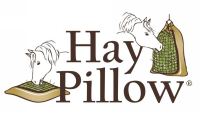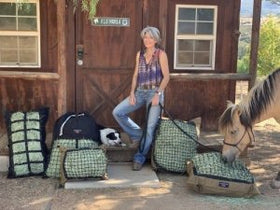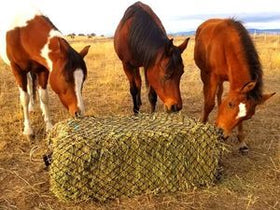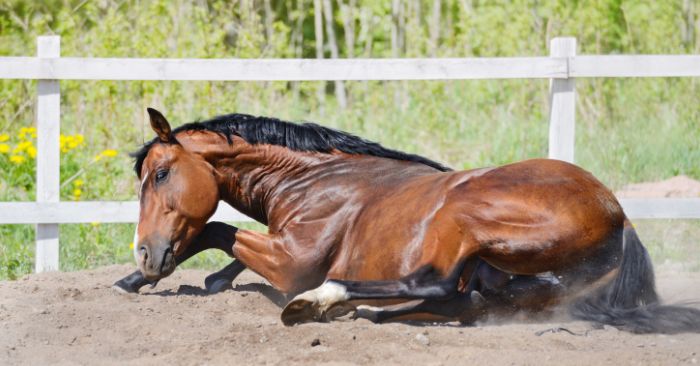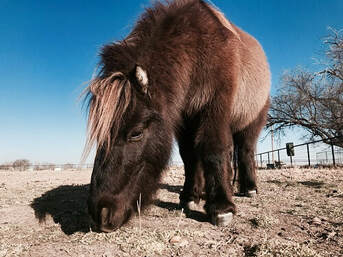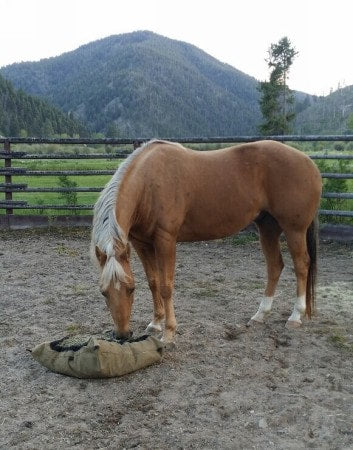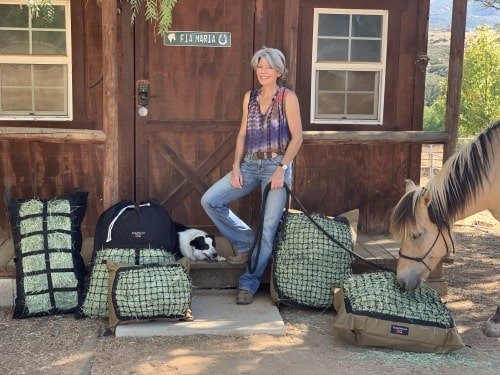Sand Colic - The Surprising (Simple) Cure & Prevention
Read on to learn the most effective means for removal and the best way to prevent sand accumulation.

How Sand Accumulates In the Digestive Tract
Sand Colic Symptoms & Severity
- Mild sand colic symptoms include discomfort and diarrhea and may appear to be temporary. This is the time to implement reactive and proactive measures.
- Severe sand colic symptoms include weight loss, profuse diarrhea, ongoing intense discomfort resulting in eventual blockage or - worst case scenario - the intestines may become twisted, displaced or even rupture.
(Surprisingly Simple) Prevention & Cure - Hay
The University of Florida tested four means of sand removal:
- Hay fed at 1.5% of body weight
- Hay fed at 2.5% of body weight
- Hay fed at 1.5% of body weight, plus psyllium fed in a single daily dose
- Hay fed at 1.5% of body weight with psyllium fed twice daily.
Free choice hay - via slow feeders or loose - supplies a steady supply of fiber moving through the digestive tract carrying sand out with manure prior to settling in the large colon by promoting gut motility and volume. Learn how to give your horse more chew time and bulk (without the weight gain).
- Lower sand to ingesta ratio.
- Volume to carry sand through the digestive tract prior to it having the ability to settle in the lower portions of the intestines.
- Increased gut motility with a constant supply moving through the digestive tract (optimum when proper hydration and movement is present).
- Peristaltic and antiperistaltic contractions, leading to additional mixing of ingesta and sand.
Psyllium Effectiveness?
However, a study conducted at the University of Illinois over an 11 day period found that ponies dosed with psyllium in an attempt to remove sand were no more efficient at sand removal than ponies given a control diet. The study's conclusion: psyllium mucilloid had no apparent effect on sand evacuation from the equine large intestine.
Given the short period of time (11 days) the results may not 1) represent the effectiveness of psyllium fed over a longer period of time or 2) consider smaller volumes of ingested sand. The University of Florida’s study does, however, show sufficient hay alone is more effective than psyllium.
How to Minimize Sand/Dirt Ingestion
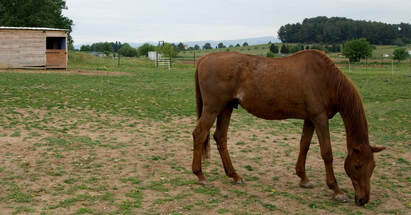
- Feed all grain or pelleted feeds in a large tub on stall mats.
- If your equine is fed meals, prevent any hay from falling on the ground. If the only source of hay is the last tiny bits (fines), scrounging for them in sand or dirt greatly increases the odds of accumulation.
- Avoid grazing on short pasture grasses.
- Provide free choice hay. If concerned about caloric intake, see our Free Choice Forage - Detailed Action Plan .
- If using slow feeders, look for those that best contain the hay from falling on the ground. Always choose a mesh size best suited for your horse's skill and frustration level.
As Nature Intended
Helpful How To Resources
- How I Chose the Best Slow Feeder
- Can Horses Eat More Hay Without Weight Gain? The Surprising Factors
- Horse Boredom Busters - Toys & Enrichment Tips for Stall or Pasture
- Are You a Prisoner of Feeding? Here's How I Broke Free
- How to Introduce & Incorporate Free-Choice Forage: A Detailed Action Plan
- Slow Feed Solutions for Any Environment
- Feeding Miniature Horses & Donkeys - Why Slow-Fed Forage is Best
- 6 Great Reasons to Feed Your Horse from Ground Level
- 9 Benefits of Slow Feeding Horses
- 7 Slow Feed Dos and Dont's for Horses
- 7 Easy Ways to Help Prevent Colic
- Equine Gastric Acid - 12 Facts You May Not Know
- Never Exercise Horses on an Empty Stomach...Ever
- Why You Shouldn't Transport Horses On An Empty Stomach
- Keeping Horses Warm Naturally – Internally and Externally
- Hammock, PD1. Freeman, D.E., Baker, G.J. (1998 Nov-Dec;27(6), Failure of psyllium mucilloid to hasten evaluation of sand from the equine large intestine. Retrieved from https://www.ncbi.nlm.nih.gov/pubmed/9845218
- Church, Stephanie L. (2001, November 2). Psyllium Mucilloid Effective In Removing Intestinal Sand?. Retrieved from https://thehorse.com/15068/psyllium-mucilloid-effective-in-removing-intestinal-sand/
- Crandell, Kathleen. (2012, February 7). Function and Health of the Horse’s Cecum and Large Intestine. Retrieved from https://ker.com/equinews/function-and-health-horses-cecum-and-large-intestine/
- Bowen, Richard. Digestive Function of Horses. Retrieved from http://www.vivo.colostate.edu/hbooks/pathphys/digestion/herbivores/horses.html
- University of Florida Study Findings Retrieved from Equinews Nutrition & Health Daily. Q & A https://ker.com/equinews/answer/equine-nutritionist-qa-sand-colic-horses/
- Kivett , Lisa. (2013, November 13). How can I prevent SAND colic in my horse? Retrieved from https://foundationequineclinic.com/blog/2013/sand
